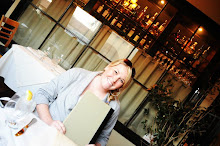 |
| Sabine (left) and Nadine (right at Hannover Airport en route to Ven |
“We are excited about getting in touch with other young scientists and expert lecturers and having the chance to discuss our work with them – hopefully being inspired and prepared for our future research. We both got into biophotonics because it’s a multidisciplinary field that can make a difference in people’s lives, with colleagues from different backgrounds and areas of study coming together to pursue a common goal. Biophotonics’11 is a great example of why we entered into this field to begin with. With the background from our own research, we are hoping the school will help us deal with the problems we are facing each day in our research and to go even further in our studies.”
Nadine is studying nonlinear laser-tissue interaction in transparent tissue by the generation and time-resolved analysis of femtosecond-laser induced optical breakdowns in different tissue-model substances. This work will contribute to a better understanding and improvement of the cutting processes during fs-laser eye surgery. Fs-laser surgeries are used in the field of ophthalmology to treat conditions such as keratoplasty, cataracts and presbyopia.
Sabine is studying the surgical insertion of permanently implanted electrodes for deep brain stimulation by means of optical imaging. Deep brain stimulation is used to treat diseases such as Parkinson’s disease, and the exact positioning of the electrodes at the target area in the brain is crucial for successful treatment. Technical challenges include the problem of intrinsic microscopic contrast of brain tissue and the development of a needle-like probe for insertion in the target region.


Comments
Post a Comment